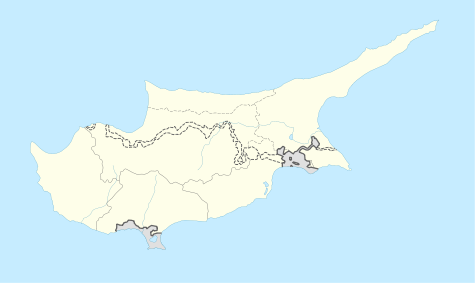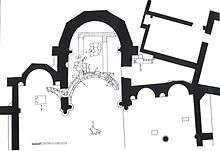Bedesten, Nicosia
| Bedesten, Nicosia | |
|---|---|
|
| |
 Nicosia | |
| Basic information | |
| Location | Nicosia |
| Geographic coordinates | 35°10′34″N 33°21′51″E / 35.1761°N 33.3641°ECoordinates: 35°10′34″N 33°21′51″E / 35.1761°N 33.3641°E |
| District | Nicosia District |
| Country |
|
| Ecclesiastical or organizational status | culture centre |
| Status | Active |
Bedesten or Bedestan is an historical building in the Selimiye quarter of North Nicosia, located directly beside the Selimiye Mosque.[1] The structure has a long and complicated history spanning more than one thousand years. Originally built as a church in about the sixth century, and expanded and rebuilt between the twelfth and sixteenth centuries, it was converted to a bedesten, a type of covered market, during the period of Ottoman rule. It is currently used as a cultural centre.
History


Byzantine period
The earliest history of the Bedesten is documented archaeologically by a Byzantine basilica, fragments of which are preserved inside the current building. These remains, which share some structural features with Afendrika and Ayios Philon, possibly date to the sixth century.[2] T. C. Papacostas has identified these remains as marking the site of the first cathedral of Saint Sophia in Nicosia.[3]
Lusignan and Venetian periods
Under the Lusignan kings the subsequent history of the building is not well documented, but some historians, including Camille Enlart, proposed that after the fall of Acre in the late twelfth century, English monks who were followers of Thomas Becket established a new Latin church on this site and dedicated it to St Nicholas.[4] This reading of the sources is not, however, universally accepted in view of the minor role played by the Knights of Saint Thomas in the history of the Latin east.[5] With the adjacent cathedral dedicated to the Latin rite, the Bedesten probably continued to serve an Orthodox role. For reasons and circumstances that are unclear, the church was expanded several times and rebuilt during the fourteenth and the fifteenth centuries. This attests to a thriving position of Greek Orthodoxy despite on going frictions with the Roman church. During the Venetian rule of the island, the Bedesten was used as the metropolitan bishopric building by the Orthodox church,[1] and dedicated to Mary as Panagia Hodegetria.[4]
Ottoman period
In 1573, a few years after the Ottoman conquest of Cyprus, the building was given by the Ottoman authorities to the foundation of Haramayn (that of the two holy cities of Islam, Mecca and Medina) to be used as a bedesten (a covered textile market). It was later used as a market for food, and by the 1760s it was a food trading center for Turkish, Greek and Armenian merchants alike. By 1873, it had been converted into a flour depot with limited sale of flour, which was brought from Kythrea, by governmental officials. It was then used as a wheat depot in the 1870s and a generic storage place for the Evkaf Administration in the 1930s.[6]
British period
In the 1880s, the first years of British colonial rule, Lord Kitchener and other prominent British men in Cyprus wanted to buy or rent the building to convert it back to a church and use it as the Church of St Nicholas once again. This was not allowed as the property of a foundation could not be sold and a shrine of another religion could not be opened within 100 yards of a mosque. The British undertook some renovation of the building, which had been damaged due to weather and earthquakes, but this was not successful in that it did not reflect some of the original architecture. With the opening of the new municipal market, Bandabulya, in 1932, the building fell into disuse.[4] In the 1930s, the building was used for storage by the Evkaf Administration and in 1935, the Department of Antiquities under Rupert Gunnis brought some medieval tombstones to the building from the Ömerge Mosque. These tombstones were displayed for some time in a room along with the room's ornate Ottoman-era ceiling.[7]
Architecture
_p057_PORCH_OF_THE_BAPTISTERY.jpg)
The Bedesten of Nicosia is stylistically very different from other bedestens in the Ottoman Empire.[6] It consists mainly of a mix of Byzantine and Gothic architecture, the latter being added by the Lusignans, but also incorporates elements of Renaissance French, Venetian and probably Spanish architectural styles. It uses a cross-shaped structural style and layout that belongs to the Byzantine style, yet incorporates a nave with a high ceiling that belongs to the Gothic style. The southern double nave is a remnant of the Byzantine church and its middle section is the oldest part of the building. The exterior of the nave in the north has the most ornate decorations and stonework in the building. This façade is across the front arches of the Selimiye Mosque and is the side where the entrance is located. The entrance is through a very ornate Gothic-style gate, with elements of the Italian Renaissance architecture added later and a statuette of St Nicholas. Baroque coats of arms are located on both sides of the entrance. This façade also has numerous animal statuettes and gargoyles.[4]
Renovation and current use
Between June 2004 and 2009, a project of renovation, funded by the European Union and the Evkaf Administration, was undertook by the UNDP PFF. During the restoration, the walls of the building were cleansed and the vaults strengthened using traditional building materials and techniques. Upon the completion of restoration, the building was reopened as a cultural center.[4] In 2009, the renovation was awarded the Europe Nostra prize. Among the activities hosted are weekly sufi dance shows.[8] The building also hosts the Nicosia Walled City Jazz Festival.[9]
References
| Wikimedia Commons has media related to Bedestan (St Nicholas of the English Church), Nicosia. |
- 1 2 Bağışkan, Tuncer (21 September 2013). "Ayasofya (Selimiye) Meydanı ve Mahallesi" (in Turkish). Yeni Düzen. Retrieved 24 July 2015.
- ↑ See Michael D. Willis, "Byzantine Beginnings," Κυπριακαί Σπουδαί 50 (1987): 185-92, available online here: https://britishmuseum.academia.edu/MichaelWillis/Excerpta-Cypriana.
- ↑ T. C. Papacostas, "In search of a lost Byzantine monument: Saint Sophia of Nicosia," επετηρίδα του κέντρου επιστημονικών ερευνών 31 (2005): 11-37. Available online here: http://kcl.academia.edu/TassosPapacostas
- 1 2 3 4 5 "Bedesten" (PDF) (in Turkish). Evkaf Administration. Retrieved 24 July 2015.
- ↑ The case rejected in Michael D. Willis, "Byzantine Beginnings," Κυπριακαί Σπουδαί 50 (1987): 192; the general assessment of the order's signficiance P. W. Edbury, The Kingdom of Cyprus and the Crusades, 1191-1374 (Cambridge: Cambridge University Press, 1991): 79.
- 1 2 Bağışkan, Tuncer (8 November 2014). "Kıbrıs'ta Osmanlı – Türk Eserleri (5)" (in Turkish). Yeni Düzen. Retrieved 24 July 2015.
- ↑ Arslangazi, Havva (2007), Lefkoşa Kent Dokusunda Mimari Üsluplar (PhD thesis) (in Turkish), Marmara University, pp. 57–62
- ↑ "Restoration and re-use of the Bedestan (St. Nicholas Church)". UNDP. Retrieved 24 July 2015.
- ↑ "Lefkoşa Jazz Festivali Başlıyor" (in Turkish). Haber Kıbrıs. Retrieved 24 July 2015.